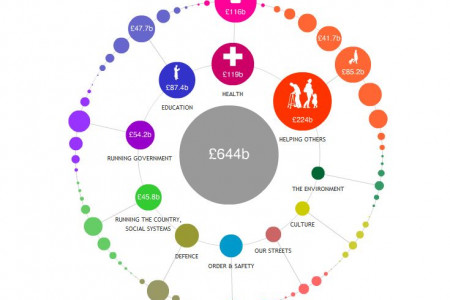
The Impact of Spending, Saving, or Investing Your Tax Refund
THE IMPACT OF SPENDING, SAVING, OR INVESTING YOUR TAX REFUND The April 17 tax deadline is fast approaching, leading many of us to wonder what we should do with our refund. Should we save it, pay down debt, or see it as "free money" and buy whatever we want? While no one answer is right for everyone, looking at potential outcomes for the different ways you could spend it will give you perspective on what the best use of your refund might be. HOW DO WE SPEND OUR REFUNDS? How do Americans plan to spend their refund this year? 43.8 PERCENT 39.4 PERCENT 28.7 PERCENT 12.3 PERCENT 11.3 PERCENT Plan to save It. Plan to cover Plan to pay down debt. Plan to use it for a Plan to take a everyday expenses. major purchase, such as a car or tv. vacation. RUNNING THE NUMBERS: WHAT'S THE BEST WAY TO SPEND YOURS? Take a look at your opportunity costs and the long-term impact when deciding how to put your refund to use. ~$2,913- According to the IRS, this year's average tax refund will be . Let's see the outcome of using this refund in four different ways: OPTION #1: FUND YOUR EMERGENCY SAVINGS OPTION #2: PAY OFF YOUR HIGH INTEREST DEBT Personal finance experts agree that you should have an emergency fund to cover six months of living expenses. If you park $2,913 in short-term, liquid assets (like a CD) at 1 percent interest, you would earn... Alternatively, you could pay off high-interest debt. Let's say you carry a $10,000 balance at 19.9 percent interest. At monthly minimum payments of $200, repayment will take nearly nine years. Worse yet, you will pay almost $11,000 in interest! But if you apply the $2,931 tax refund toward the 10 YEARS balance, your repayment time falls from nine years to just over four. 5 YEARS $145.65 $291.30 BEST PART: You pay just $3,300 in interest-a savings of more than $7,000! This is nothing to sneeze at, but it won't make you feel rich either. However, keep in mind that the purpose of this money is to be readily available for emergencies. For consumers with credit card debt, this is hands down the best option. OPTION #3: INVEST FOR YOUR RETIREMENT OPTION #4: PAY DOWN YOUR MORTGAGE Still another possibility is putting the refund to work for your future by investing in a Traditional or Roth IRA. A $100,000, 30-year mortgage at 4.33 percent interest with monthly payments of $496.63 would take from Jan 1, 2012 until Jan 1, 2042 to repay. Assuming a 6 percent annual return, placing $2,931 into an IRA would yield.. TOTAL INTEREST: $78,788.46 5 YEARS 10 YEARS YEARS EARLY $5,249 But if you apply your $2,931 tax refund as a lump-sum $3,922 1.5 prepayment this month, your repayment date accelerates to May 1, 2040! This is clearly a superior option for consumers without debt, as you can nearly double the initial investment. TOTAL INTEREST: $71,486.21 INTEREST SAVED: $5,476 AFTER TAX DEDUCTION * Assumes a 259% marginal income tax rate SNAPSHOT VALUE OF THE ALTERNATIVES Going on a $2,931 shopping spree might be tempting, but take a look at the longer-term value of the alternatives. $7,000 $5,476 $5,249 $219 EMERGENCY SAVINGS IRA MORTGAGE PREPAYMENT CREDIT CARD DEBT Use these numbers as tools, not rules for determining where you will get the most value with your tax refund. The right decision depends on what's best for you-your unique financial situation, life circumstances, and goals. SOURCES: National Retail Federation, Google Advisor, Bankrate, Vlender jemstep
The Impact of Spending, Saving, or Investing Your Tax Refund
Source
http://www.j...ax-refund/Category
EconomyGet a Quote










